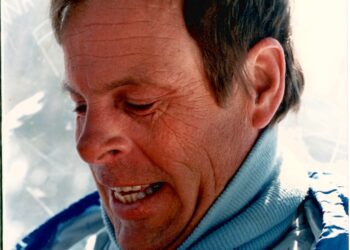By Dr. Jeff Daniels EBS Medical Columnist
For most people visiting from other parts of America, Big Sky’s altitude is pretty high. We’re not as high as some places in Colorado and certainly far from the heights trekkers in the Himalaya reach, but we’re far enough above sea level to induce several types of medical problems in people who are susceptible to the effects of altitude.
Oxygen is the key player in all of this. We all need the right amount of oxygen to enter our bloodstream through the lungs in order to ensure normal function of the brain, heart and other vital organs. There is less oxygen in the air as you go higher in elevation. The air gets thinner, which basically means that there are less air molecules to breathe in. Air is basically made up of oxygen and nitrogen, with much smaller amounts of water vapor, carbon dioxide and other, rarer gases.
At sea level, the air is 21 percent oxygen. In Big Sky, the percentage of oxygen doesn’t change in relation to nitrogen and other gases; there’s just less molecules of everything! So we have to adjust.
Everybody who comes to Big Sky from a lower elevation goes through the same physiological changes that help their body absorb the right amount of oxygen. Simply put, people start to breathe a little faster from the time they get off the plane in Bozeman, drive up the Canyon, and arrive in Meadow Village or Mountain Village.
Breathing involves intaking oxygen and expelling water vapor and carbon dioxide. Breathing faster is also called hyperventilating. For most, it’s imperceptible. With each extra breath, the body gains the right amount of oxygen from the thinner air. However, there’s a price to pay for all of this: each extra breath makes the body lose more water vapor and carbon dioxide than it would at sea level.
Water loss will immediately trigger a thirst mechanism, and most of us can keep up with that and drink the proper amount of water to prevent dehydration. Carbon dioxide loss is a different story, and this is what causes symptoms of altitude adjustment like headache, nausea, irritability and fitful sleep in some susceptible individuals.
Carbon dioxide is very important in the body as a regulator of the amount of acid required for normal bodily functions. Wherever you are, your rate of breathing is constantly regulating the amount of carbon dioxide entering or leaving the body so that the acidity in the fluid surrounding the brain, usually referred to as the pH, stays constant.
When you change your normal environment by coming to higher elevation, the brain overrides the need to regulate carbon dioxide because of the more dire need to get enough oxygen. In doing so, the pH rises slightly. Most people don’t feel a thing, but some do suffer from the symptoms of this adjustment.
It takes months to be able to slow down the hyperventilation induced by high altitude. We do this by building up more red blood cells, which absorb more oxygen. The increase in red blood cells is accompanied by other physiological changes that make it easier for oxygen to leave red blood cells and move into the muscles, heart and brain.
Even though the body immediately makes adjustments to correct the pH change, it takes about a week before they’re truly effective. By that time, you’re flying back to sea level!
The medication Diamox speeds up the process, and can both treat and prevent altitude adjustment symptoms.
Dr. Jeff Daniels was the recipient of the 2016 Big Sky Chamber of Commerce Chet Huntley Lifetime Achievement Award and has been practicing medicine in Big Sky since 1994, when he and his family moved here from New York City. A unique program he implements has attracted more than 700 medical students and young doctors to train with the Medical Clinic of Big Sky.













